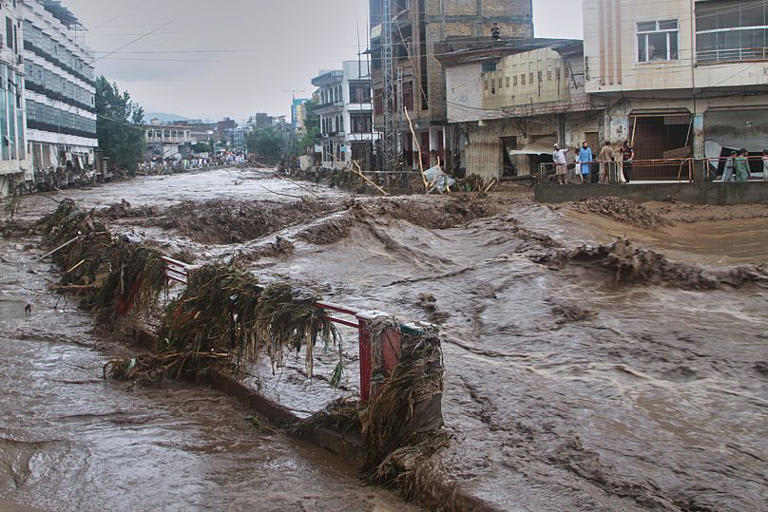Flash floods have devastated the mountainous regions of India and Pakistan over the last few weeks, claiming hundreds of lives and leveling villages. The floods are mostly caused by a phenomenon referred to as a cloudburst—a short but intense rainstorm that can easily inundate local infrastructure and also pose huge threats to human life. This article delves into what cloudbursts are, why they are increasing, and how better to prepare for such heavy weather phenomena.
What Is a Cloudburst?
A cloudburst is a rainstorm where a small area is subjected to an unusually large amount of precipitation in a very short duration of time, typically greater than 100 millimeters (about 4 inches) in an hour. This intense precipitation can lead to flash flooding, landslides, and other types of rapid water flow, especially in hilly or mountainous terrain.
Chief Features of Cloudbursts Sudden Onset: Cloudbursts occur with little or no warning signals, making them even more dangerous. Localized Effects: The effects are generally localized to a small area, yet the damage is catastrophic. Short Lived: Despite their ferocity, cloudbursts are generally short-lived, lasting less than an hour in the majority of instances. Recent Catastrophic Events Pakistan’s Buner District
A devastating cloudburst occurred in Buner district in Pakistan’s Khyber Pakhtunkhwa province in August 2025, resulting in flash floods, landslides, and mudflows. Heavy rainfall of over 150 millimeters within an hour alone led to the loss of at least 337 people’s lives, and many more are missing. Entire villages were swept away, and rescue operations are ongoing in remote places with the assistance of army back-up and heavy equipment.
India’s Uttarakhand Region
Similarly, the Indian state of Uttarakhand witnessed catastrophic destruction from cloudbursts. The heavy rains caused flash floods that destroyed homes, washed away roads, and resulted in dozens of casualties. The event reminded one of the 2013 tragedy that claimed over 6,000 lives .
Why Are Cloudbursts Increasing?
There are several reasons why cloudbursts are increasing in frequency and intensity in the region:
1. Climate Change
Global warming has raised temperatures, allowing the atmosphere to hold more water. Greater content of water during storms may result in heavier rains. In nations like Pakistan, every 1°C rise in temperature allows the air to carry about 7% more water, making cloudbursts more virulent.
2. Melting Glacies
The rapid melting of Himalayan glaciers and nearby mountains contributes to increased water flow into rivers and streams. Excess water will make flooding more severe during rainstorms.
3. Urbanization and Deforestation
Rampant development and deforestation in mountainous areas reduce the natural water-holding capacity of the land. Loss of vegetation and building construction along slopes and rivers increases the risk of landslides and flash flooding.
Impacts on Communities
The cloudburst impacts extend beyond immediate physical damage:
Loss of Life: Flash floods may lead to death in a matter of minutes, especially where the areas are densely populated or poorly constructed. Displacement: Families are forced to evacuate their homes, leading to temporary or long-term displacement. Economic Losses: Crop, animal, and infrastructure loss can have long-term economic impacts on communities. Psychological Trauma: Survivors can develop long-term mental health problems because of the shock and traumatic nature of the incidents. Preparedness and Mitigation Steps
Although cloudbursts cannot be forecasted with complete accuracy, people can take preventive measures to minimize their susceptibility:
1. Enhanced Early Warning Systems
Establishing and instituting proper early warning systems can alert communities in advance, enabling them to evacuate and take precautions accordingly.
2. Sustainable Land Use Planning
Prevention of construction in flood-prone sections, especially along riverbanks and in steep slope areas, can minimize the chances of damage. Implementing zoning laws restricting construction in risky zones is the priority.
3. Reforestation and Soil Conservation
Plants can be grown through tree planting or use of soil conservation techniques to render the land more pervious to water, reducing surface runoff and landslide hazards.
4. Community Education and Training
Empowering communities with knowledge about the perils of cloudbursts and emergency response training can make individuals react quickly and efficiently during cloudbursts.
5. Infrastructure Strengthening
Building infrastructure that is capable of withstanding heavy rains and floods, such as reinforced bridges, culverts, and drains, is crucial in reducing damage during cloudbursts.
Conclusion
Cloudbursts constitute a growing and serious hazard for the mountainous Indian and Pakistani states. While they cause catastrophic short-term impacts, long-term strategies for adaptation to climate change, sustainable development, and community preparedness can mitigate the hazards caused by such extreme climatic phenomena. If communities anticipate the science of cloudbursts and take proactive measures, they can successfully safeguard lives and livelihoods from the rising hazards of climate change.
